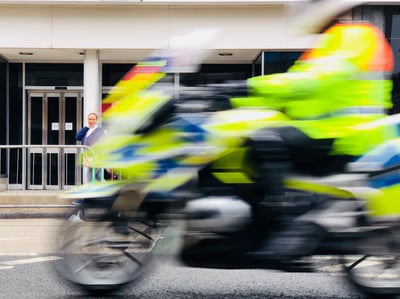 Police pursuit technology
Police pursuit technology
The live police pursuit of O.J. Simpson was the first memorable live broadcasting of a police pursuit of a suspect. Limitations, such as visibility and quality of broadcast were dependent on the line of sight connection by the helicopters and news channels. Nowadays the police can use multiple SIM cards in one camera with an attached encoder to ensure continuous and secure streaming in high broadcast quality.
By using multiple SIM cards in one encoder, the footage is securely streamed through several cellular networks, which enhance the security of the transmission. It also enhances the reliability of the transmission as the variances of the network availability are automatically adjusted for strength and data load.
Portable live streaming equipment
The advances in portability and streaming of broadcasting tools allow more police forces to actively film pursuits. The police can access and broadcast live from a much wider range of locations, which traditionally they couldn’t reach with a fixed camera like CCTV or areas which didn’t have reliable wifi/satellite reception.
The modern, lighter broadcasting devices (like a ZAO-s, which is very robust but only weighs 400g) means that mobility of live broadcasting is achieved through using action cams. The footage can be recorded or streamed live from a whole host of transportation options: emergency services drones, helicopters, cars, motorbikes, bikes and bodycams.
Drones increase police effectiveness
Drones are a favourite tool for the police as they can stream from multiple angles and monitor tall buildings quickly. Drones can enter and approach dangerous locations, allowing police to keep a safe distance, especially if the perpetrator is armed and dangerous.
The emergency services can now use encrypted broadcast, with less than one-second latency. This ensures that the whole team and command centre can be updated, clearly and demonstratively as the pursuit unravels in real time. It also means that the public will not necessarily be granted access to the footage, unless it is in the public services interest. Live streaming drones is more subtle than helicopters and can be used to greater effect in covert operations, gathering evidence or thwarting terrorist attacks and denying them their much-craved publicity.
GPS tracking in police pursuits
In the police control room IT eco-system GPS tracking can be added to the monitoring. By displaying the pursuit on a map, it enables a better and efficient coordination of resources in an adrenaline driven environment. With thermal imagery the pursuit can also be supplemented to covert operations and add a level of safety if weapons or fire hazards add a complicated element to the pursuit.
Improve audio for surveillance
The sound quality of mobile broadcasting is often better than fixed CCTV. Fixed cameras rarely have localised sound, and no sound filters, which mobile cameras have. The audio from CCTV is rarely utilised as admissible evidence. The mobile cameras offer much more flexibility when voices are needed for evidence. For example the encoders can broadcast quality sound, which can be filtered (post-operation) to cut out interference and background noise.
Police have an ever-growing technology toolkit, which cost-effectively enable pursuits to be controlled, monitored and intervened. The video recordings enhance evidence gathering for prosecution and importantly improves safety of field agents.




